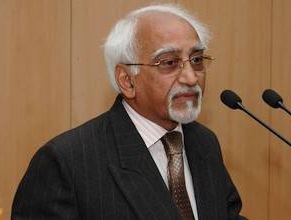By M. HAMID ANSARI, FORMER VICE-PRESIDENT OF INDIA

January 30 is an important date in the calendar of our society. It is the day of the martyrdom of Mahatma Gandhi, the day a fanatic propelled by an extremist ideology resorted to violence to silence him.
The world lamented and people expressed grief in their own ways.
The poet Josh Malihabadi did it in a long poem that had both remorse and satire:
Dehr par teri shahadat ne ye sabit kar diya Had se barh kar nek hone kis qadar hai na-rawa Qatilon main qatl-e-insani pe rona jurm hai Tukhm-main neki sarzamin-e-dil main bana jurm hai
Gandhi ji died as he lived: dedicated to his principles, to his own version of modernity premised on Ahimsa. On his last birthday on October 2 1947 his request to visitors was ‘to pray either for present conflagration should end or he be taken away. I do not wish another birthday to overtake me in an India still in flames.”
Mahatma Gandhi sought concord in a world of discord. He had witnessed the latter in all its dimensions and consciously worked to counter it.
It has to be admitted that he failed and that the virus of discord and hatred has continued to determine public perceptions. What is India? The poet Raghupati Rai Firaq shed light on the process of the formation of India:
Sar zamin-e-Hind par aqwal-e-aalam ke Firaq Qafle baste gaye, Hindostaan banta gaya
What was the character of the end product? A poet shed light on it in a couplet:
Kehte hain bhai bhai hain ahle-watan tamaam
Phirte hain aasteenon main khanzar liye huia
It was thought that the values prescribed in the Constitution, particularly the principle of fraternity in the Preamble, and of the duty in Article 51A(e) ‘to promote harmony and the spirit of common brotherhood among all the people of India transcending religious, linguistic and regional and regional or sectional diversities, would induce the required correctives. The Indian reality however was found to be more complex. It was summed up by a poet of our times, Amir Chand Bahar:
Insaan hi insaan se badzan kyon hai Insaan hi insaan ka dushman kyon hai Kehne ko to Ram Ram kehte hain sabhi Kardar se har admi Raawan kyon hai?
TI Communal disharmony had afflicted India before, and since, Independence. Its seriousness took time to be recognised. Finally, and after the experience of several decades, the Government constituted the National Integration Council in 1960 and the National Foundation for Communal Harmony in 19 Various other legislative and administrative measures were taken from time to time. A Communal Violence (Prevention, Control and Rehabilitation of Victims) Bill was introduced before 2014 but has remained unattended. The hesitation in accepting this as a problem was itself indicative of the mind seas Incidence of violence can and do happen sporadically. Organised violence however is another matter and results from hate that is nurtured purposefully. Instances of the latter have occurred in our society and invariably involve political planning and administrative connivance. They are sustained by administrative and civil society facilities. An answer to this mindset was given in a popular couplet:
Mazhab nahin sikatha aapus main bair rakhna
Hindi hain hum watan hai Histostaan hamara
The attitude of evading, or facilitating, the issue however has deeper causes. An eminent sociologist has shed light on it:
The empirical reality of India does not suit the institution of the nation-state which relentlessly pursues cultural homogenisation in the name of cultural consolidation, and that groups and communities unwilling to surrender their cultural identity to avail of equality in citizenship entitlements should be coerced to do so in the name of national integration. The way out is the creation of a nation state which recognises cultural identity and celebrates it’

Thus the challenge to our liberal polity established by the Constitution is both ideological and practical. The latter can be countered by a corrective administered by the electoral process as has been attempted from time to time. The former, on the other hand, requires a careful examination of the philosophic backdrop, ideological pronouncements and terminological sophistry of the political hypothesis that succeeded at the polls in 2014 and again in 2019, and which is optimistic about the immediate and foreseeable future.
To this end it puts across a (slanted) view that while diversity is inherent in the Indian scheme of creation and is the manifestation of a cosmic entity in different forms, its acceptance in the context of the Bharatiya view of life, requires the exclusion of all alien views.
In the process it seeks to erase other influences down the ages, including the existential reality of over a thousand years of Indian history, and to impose an imagined version of cultural homogeneity with all its political connotations, leading to what has been called by informed observers an ethnic democracy’. Do we need to bear this cost?
The challenge is real; it is also urgent. It has to be met in terms of ideas, practices and day-to-day behaviour. This is what the poets advocated; this can be turned into reality by public action.
This is an excerpt from the address by M. HAMID ANSARI, former Vice President of India at the National Convention on communal harmony organised by the SOCIETY FOR COMMUNAL HARMONY on 76th death anniversary of Mahatma Gandhi on January 30, 2024, in New Delhi
